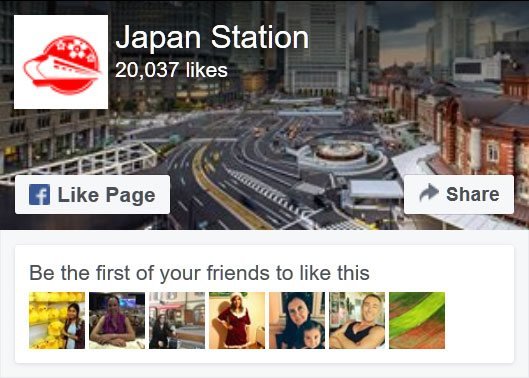Japan has an unsurpassed rail network, with high-speed, intercity, local and subway trains linking many popular destinations. You can easily use trains only to get around during your journey in Japan, and you wouldn’t have to take any other form of transport.
But since Japan is an archipelago of over 6,000 islands, there are many places that rail networks don’t reach. For those who want to explore more of Japan’s hinterlands and remote areas, renting a car can give your itinerary greater range and flexibility. If you want to go to a remote onsen hot spring, ski resort or beach, for instance, a rental can be the perfect solution.
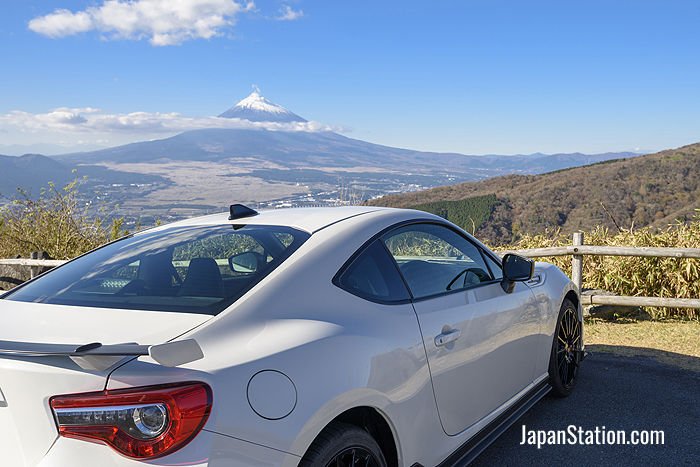
Driving in Japan can bring you closer to breathtaking views
Rental agencies are found nearly everywhere, cars are reasonably priced, starting at roughly 5,000 yen for 24 hours, and vehicles come equipped with navigation systems that make getting around a snap. Another plus when it comes to driving in Japan is that the highway, bridge and car ferry network is extensive and roads are very well maintained.
You can compare rates from multiple rental agencies and book a car rental online through our search engine, it’s easy and fast to use!
With foreign visitors to Japan marking a record-high of 31 million in 2018, more and more travelers are renting cars. According to the Japanese Ministry of Land, Infrastructure and Transport, the number of foreign travelers who used rental cars grew from 179,000 in 2011 to 705,000 in 2015, nearly a four-fold increase over five years. These figures show that not only is driving in Japan very doable, it’s becoming an increasingly important way for travelers to get around. This article will give you an overview of how to rent a car in Japan and some of the best places to drive.
Table of Contents
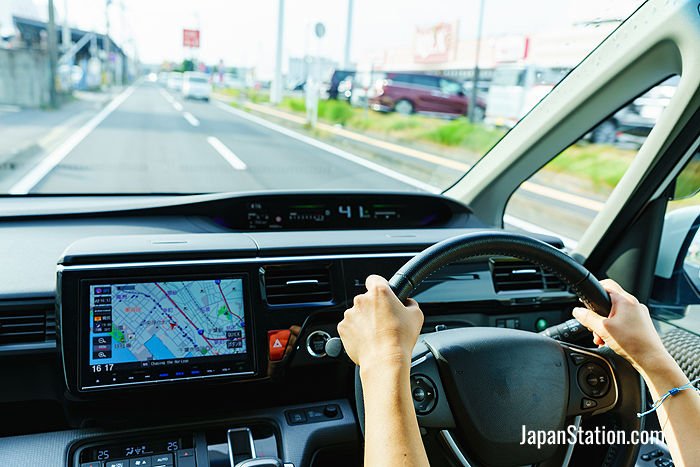
It’s fun to get behind the wheel and enjoy Japan’s excellent road network
Car Rental Basics
Renting a car and driving in Japan are relatively straightforward. There are a few important things you need to know: you must have an international driver’s permit and driving is on the left.

In most cases, an International Driver’s Permit is required for foreigners who want to drive in Japan
International Driver’s Permit (IDP): Japan is party to the 1949 Geneva Convention on Road Traffic and requires foreign drivers to have a valid IDP, which is a passport-style identity document in multiple languages. IDPs are issued in your country of residence, often by local automobile associations. They are valid for one year and are not renewable. Based on your local driver’s license, they indicate what class of vehicle you are entitled to drive abroad. You must carry your original driver’s license for your IDP to be valid overseas.
Some countries and territories (Switzerland, Germany, France, Taiwan, Belgium, Slovenia, Estonia and Monaco) that do not issue IDPs have separate arrangements whereby translated driver’s licenses are valid for one year of driving in Japan.
As a foreign driver, you will be asked to present your passport when renting a vehicle.
Driving on the left and other rules: If you’re from the UK, Australia, southern Africa, or a number of countries in Europe, Asia, Oceania and the Caribbean, you’ll feel right at home driving in Japan. But if your country is one of the 70% with right-hand drive, driving in Japan may require an adjustment. For veteran motorists, driving can often become an automatic process and it’s easy to let your thoughts drift. It goes without saying that in an environment where driving is on the opposite side, it’s vital to always remember to stay in the proper lane, especially when exiting a parking lot, making a turn and merging into traffic.
Overall, Japan’s road rules are fairly straightforward. There are several rules to take note of:
- The legal age for driving is 18.
- Turning at red lights is prohibited.
- Vehicles turning right must yield to those turning left at intersections.
- Driving while intoxicated or talking on or using a mobile phone are strictly prohibited.
- Speed limits are 80 to 100 kph on highways, 50 to 60 kph on major roads, and 30 to 40 kph on minor roads.
- Parking on urban streets is usually prohibited, and offenders may be ticketed or have their vehicles towed; special zones have parking meters.
- Drivers must stop at railway crossings.
How to rent a car
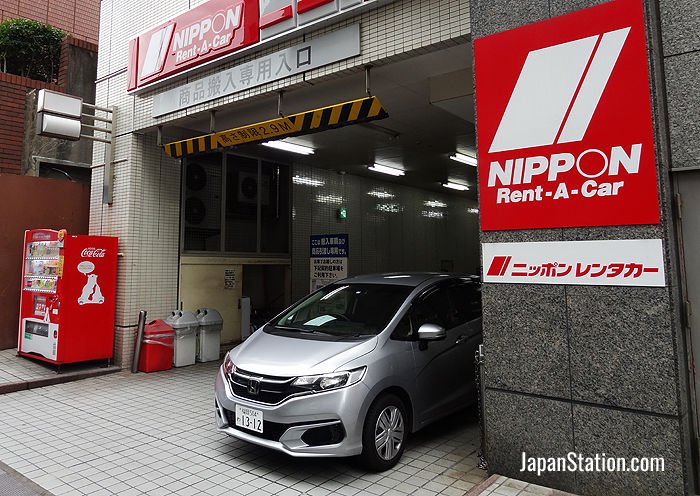
Major car rental agencies in Japan have multi-lingual websites, making reservation a snap
If you have an IDP and a credit card, renting a car in Japan is quite easy. The major agency chains have English-speaking call center staff and multilingual websites. They include are Nissan Rent a Car, Toyota Rent a Car, Nippon Rent a Car, Orix Rent-a-Car, Times Car Rental, Budget Rent a Car, and Eki Rent-a-Car; the latter is also known as JR Rent-a-Car and is affiliated with the Japan Rail group of companies—it has outlets at major railway stations. There are other chains and independent agencies but they mainly cater to Japanese drivers; the major chains above have websites in English as well as Japanese, Chinese and Korean. Most counter staff at travel hubs will speak some English.
The simplest way to rent a car in Japan is as follows:
- Determine where you want to begin your journey
- Check the internet for agencies there
- Chose a car and book online or by phone
Let’s say you want to explore Shikoku, one of Japan’s main islands, by car and you want to begin your journey in the Tokushima City. An internet search for “Tokushima rent a car” will produce a list of agencies in the city and at Tokushima Awaodori Airport, including Nissan, Budget, and Toyota. Of course, it’s also possible to book by phone but you’ll likely need a Japanese speaker to help.
Returning at another location
It’s often possible to return the vehicle at a different agency branch than the one you rented it from, which is called norisute (乗り捨て) in Japanese. There are fees for this, however, and they can be considerable. Nissan’s are one example: it’s free if the drop-off location is no more than 20 km from the pickup location, 4,320 yen if it’s under 50 km, 8,640 yen for locations 50 km to 100 km away, and 4,320 yen for every 50 km over 100 km.
Vehicle types
Japanese rental agencies generally classify their fleets as follows.
- Mini, subcompact, compact, or Kei: These are compact cars with engine capacities of 660 or 1,000 cc. Examples include: Toyota Vitz, Daihatsu Move, Suzuki Wagon R.
- Standard, sedan or midsize: These vehicles generally have engine capacities of 1,200 cc and up. Examples include: Nissan Wingroad, Toyota Corolla.
- Luxury, full size or premium: These vehicles generally have engine capacities of 2,000 cc and up. Examples include: Toyota Crown, Nissan Skyline, Subaru Forester.
- Others: Agencies have various specialty classes including green or hybrid cars (e.g., Toyota Prius), minivans (e.g., Honda Odyssey), luxury sedans (Mercedes S class) and crossovers (e.g., Nissan X-Trail).
Car Rental Rates in Japan
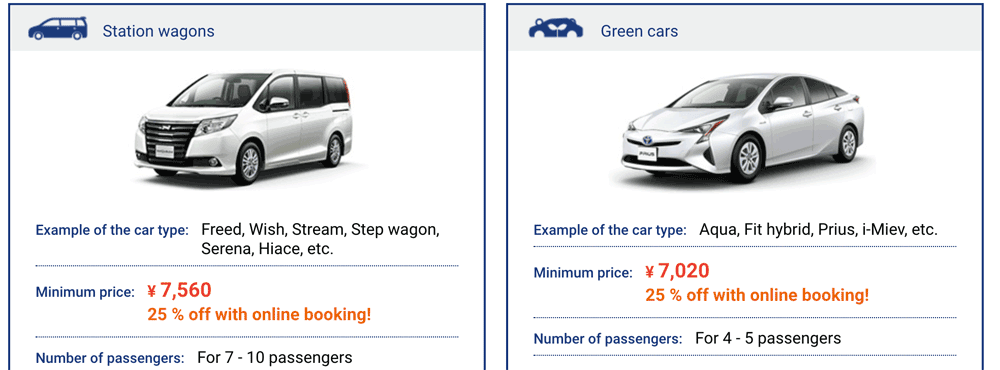
Car rental rates
Rates vary across agencies but here are some examples:
Toyota Rent a Car Toyota Vitz (compact)
Up to 6 or 12 hours 5,400 yen
Up to 24 hours 7,020 yen
Additional day 5,940 yen
Additional hour 1,080 yen
Nissan Rent a Car Nissan Wingroad (standard)
Up to 12 hours 9,180 yen
Up to 24 hours 10,800 yen
Additional day 9,180 yen
Additional hour 1,404 yen
Nippon Rent a Car Toyota Alphard (full-size premium)
Up to 6 hours 16,740 yen
Up to 12 hours 21,600 yen
Up to 24 hours 27,000 yen
Additional hour 2,916 yen
Additional day 18,360 yen
Orix Rent-a-Car Mercedes S Class (P Class sedan)
Up to 6 hours 70,200 yen
Up to 12 hours 101,520 yen
Up to 24 hours 117,720 yen
Additional day 88,560 yen
Additional hour 18,360 yen
Note that rental agencies charge higher rates during holiday seasons in Japan, which are usually late December to early January, late April to early May, and mid-August; for Hokkaido, the high season also extends through all of July and August.
Extras and miscellaneous fees
Extra features such as child seats, winter tires, ski racks and, in some cases, four-wheel drive carry additional fees. If you fail to refill the tank, you will be charged extra.
Rental contracts and insurance
Drivers are asked to sign a rental contract in Japanese, but you can usually find examples in English on agency websites, such as this one from JR Rent-A-Car.
Basic insurance and compensation are included in the rental cost. The following table from Toyota Rent a Car is a good example of such policies.

Toyota Rent a Car insurance coverage
A Non-operation Charge (NOC) will be applied if the vehicle requires repairs or significant cleaning during or after use. The charges are generally 20,000 yen if the vehicle is returned to its designated location, and 50,000 yen for other situations. While insurance on your credit card may cover this, agencies offer an optional NOC plan, usually 540 yen per day.
Another option is Collision Damage Waiver plans, which give drivers a waiver of the deductible in case of accidents. They start around 1,300 yen per day.
Be sure to check the details of your insurance policy before you sign a contract. Of course, check the car carefully with a staff member and sign the assessment form before starting your journey.
Driving, parking and fueling
If you remember to stay on the left and observe the speed limits, as noted above, driving in Japan is fairly straightforward. Directional street signs showing destinations are usually written in Japanese and in Roman letters. Other signs to note include the following.
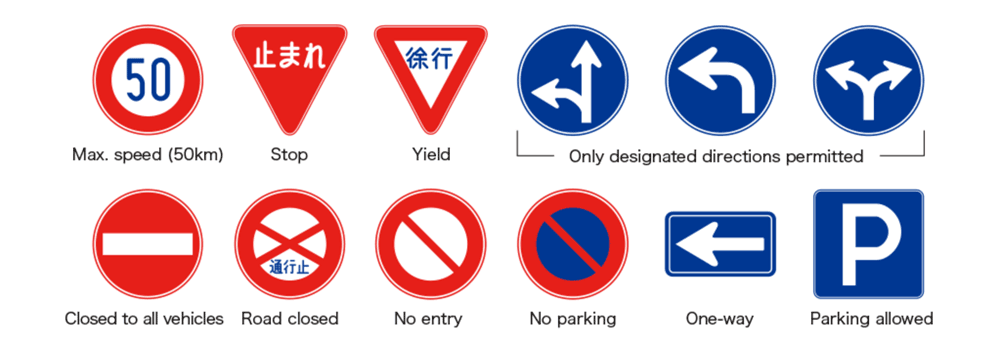
Road signs in Japan
While parking in rural areas is often free, parking can be very expensive in urban centers, with rates such as 310 yen every 30 minutes in Tokyo’s Ginza district. Parking on the street is generally prohibited, so look for parking lots. Many have automatic undercarriage barriers that release only when the fee has been paid. Another form of parking lot is the vertical carousel garage, where drivers park their car on a rotating platform before the vehicle is stored in a rotating rack. Staff at these facilities will help you through the procedures. Note that most drivers in Japan park by backing into a slot.
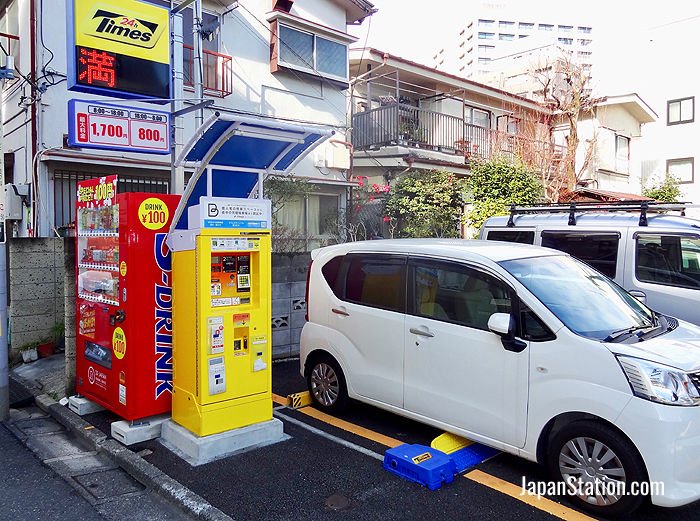
Times24 parking lot
Urban parking lots often indicate whether they’re full or not. The kanji 満, upper left, shows this lot is full. The kanji indicating vacancies is 空
Times24 is one of many parking lot chain operators. Its lots feature the automatic undercarriage barriers and payment machines. As seen in the photo above, rates for suburban Tokyo might be a maximum of 1,700 yen from 8 am to 6 pm, and 800 yen from 6 pm to 8 am.
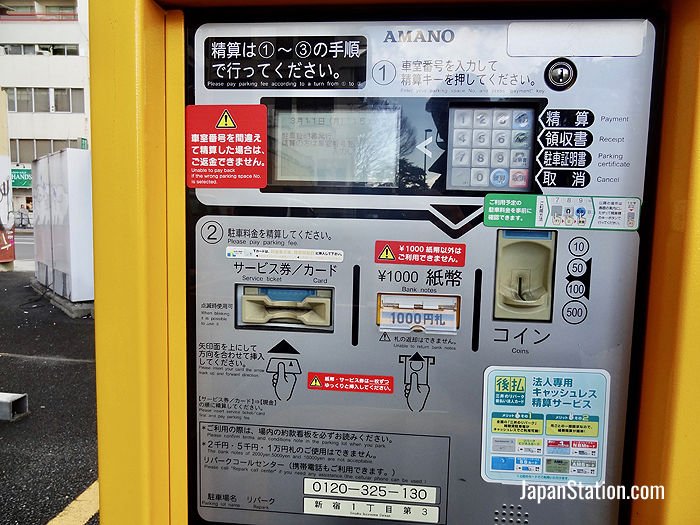
This payment machine has English instructions, but many are Japanese-only
Some payment machines have English instructions. As seen on the one above in Tokyo’s Shinjuku, operated under the Mitsui no Repark brand, customers are asked to key in their parking space number on the keypad on the upper right. The machine then issues a service card, which users insert back into the machine when they’re finished using the lot. They can then pay the fee by cash or credit card, at which point the automatic undercarriage barrier will lower, allowing the vehicle to depart.
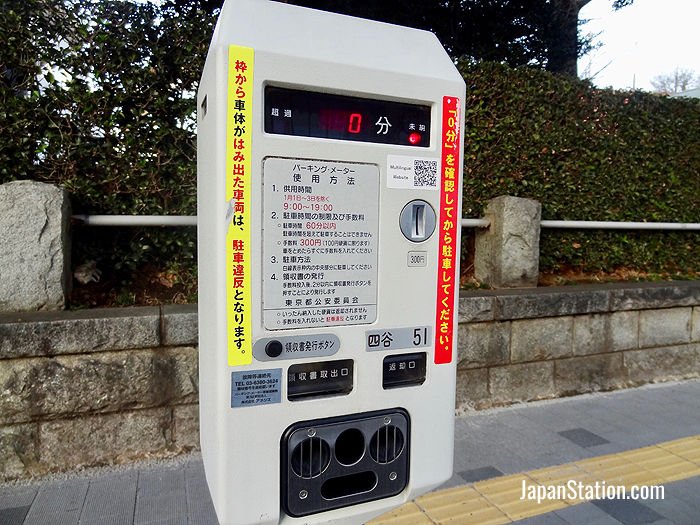
This parking meter in central Tokyo can be used from 9 am to 7 pm every day except January 1 to 3
Some major streets in Japanese cities have metered parking spaces. The meter above in central Tokyo has a sensor to detect the presence of a vehicle and a QR code linking to a multilingual guidance website. The top display indicates minutes, and the space can only be used if the display shows zero. The meter only accepts 100-yen coins. The price for one hour of parking is 300 yen.
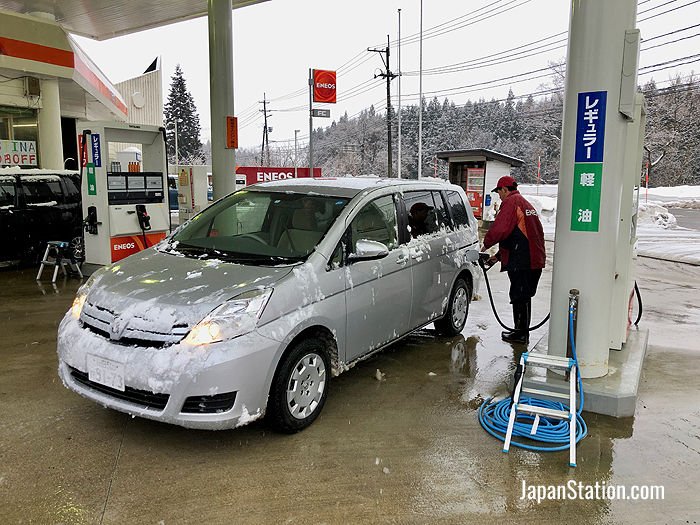
Most gas stations in Japan offer full service
Gas prices vary across Japan, but it February 2019 they were around 139 yen per liter of regular. From November 2018 to February 2019, the average price was 142.13 yen, according to GlobalPetrolPrices.com.
Nearly all gas stations in Japan offer full service (フル). You might want to remember the words for “full tank” (mantan), “cash” (genkin), and credit card (kureditto kaado). Staff are usually very helpful, and not only will they fill your tank and wash your windshield, they often offer to take any trash you have in the car and to ask passing cars to yield so you can pull out of the station.
If you’re using a self-serve station (セルフ), you’ll likely have to pay in advance, either at the both or by credit card at the pump. Menus and displays will be in Japanese only, so look for “regular” (レギュラー).
Things to keep in mind

Summer is high season for driving in Hokkaido
Here are a few things to keep in mind to make driving in Japan as smooth as possible.
Navigation
Cars come equipped with navigation/GPS systems and most have an English-language menu option. The easiest way to use these is to input the phone number of the place you’re heading to, such as a hotel or ryokan, and then simply follow the prompts and directions. The system will alert you to turns when you’re 700 meters and 300 meters away. If you have a Japanese-only system, try selecting “menu” (メニュー), “destination”(目的地) and “phone number” (電話番号). For natural attractions such as lakes or waterfalls, you can input its Mapcode, a unique code up to 12 digits long with or without an asterisk in it. For instance, the Mapcode for Mt. Fuji is 689 072 801*52. To find the code for an attraction, simply search for it at https://japanmapcode.com/en/. Note that city centers often feature one-way streets, making navigation a challenge.
Highway tolls
Many highways in Japan have tolls, which can easily add up. Driving the 550 kilometers from Tokyo to Osaka, for instance, costs about 12,200 yen. You can either pay cash (look for the toll booths marked ippan (一般) or use a contactless electronic toll collection (ETC) card, which are rechargeable cards that go into your car’s ETC slot. Note that even if you don’t have an ETC card, these units may automatically issue loud oral warnings when you start the engine and approach a tollbooth. ETC cards usually require a Japanese credit card but some rental agencies and third-party providers offer them. Foreign drivers can also obtain one of several expressway passes to pay for tolls. These are available from car rental agencies and they include the Japan Expressway Pass, which offers toll-free driving on most expressways for 20,000 yen (seven days) or 34,000 yen (14 days); see the website for details. There are also regional expressway passes for Hokkaido, Kyushu, Tohoku, central Japan, and Western Honshu and Shikoku.
Hazards
Japan’s cities feature congestion and dense traffic, with bicycles, scooters and pedestrians moving very close to other vehicles, so exercise caution at all times. Another thing to be aware of is that many drivers will run through yellow lights and even the first few seconds of a red light. In rural areas, beware of slow-driving tractors and farming pickup trucks.
High season
As noted above, holidays and summer in Japan are high season for driving. Reserve your vehicle early if you’re planning to drive in Japan during late December to early January, late April to early May, and mid-August, or all of July and August in Hokkaido.
Japan’s Best Drives
Biei roads, Hokkaido
Rentals available at: Shin-chitose Airport, Sapporo, Asahikawa Airport, Asahikawa.
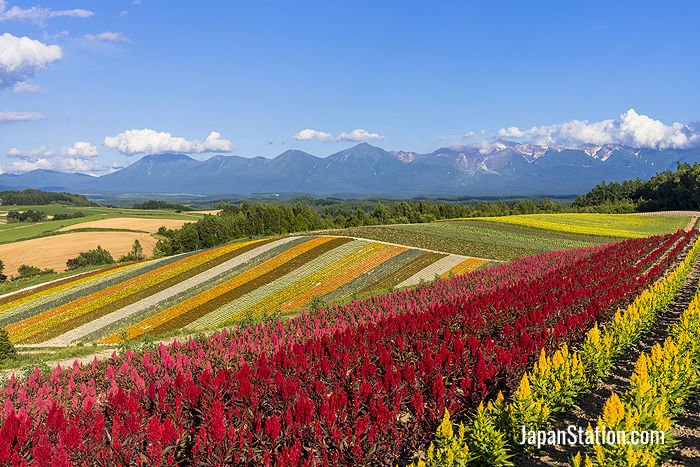
Hokkaido’s Biei is famed for its beautiful fields and rolling hills
Biei offers some of the prettiest drives in Hokkaido. The 14-km Patchwork Road winds through colorful fields of flowers framed by mountains in the distance. Local trees have nicknames such as Mild Seven and Seven Stars because they’ve been featured in cigarette advertising in the past. Panorama Road, meanwhile, is gives drivers the chance to enjoy an 18-km cruise through hilly countryside, with Shinei-no-Oka Observatory Park one of several spots to take panoramic pics.
National Route 273, Hokkaido
Rentals available at: Asahikawa City, Asahikawa Airport.
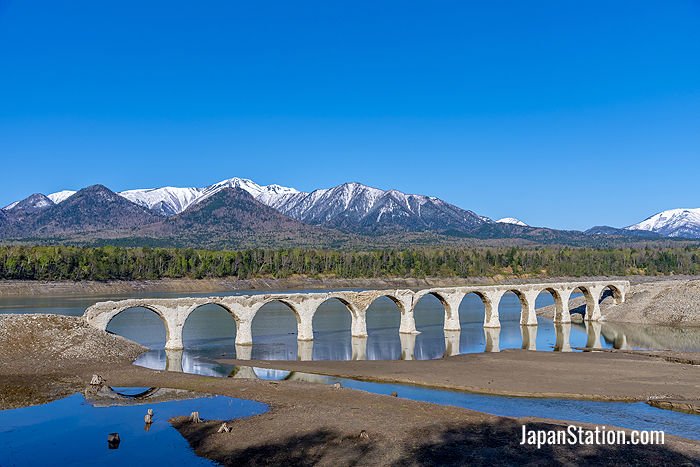
Lake Nukabira’s Taushubetsu Bridge, built in 1937, is known as the “phantom bridge” because it becomes submerged around June every year.
Connecting Obihiro and Monbestsu in Hokkaido, National Route 273 winds 235 km through the heart of Japan’s northernmost prefecture. Also known as Nukabira National Highway, it’s a spectacular drive through forests that takes in Lake Nukabira, Mikuni Pass, and the approach to Daisetsuzan National Park.
Bandai-Azuma Skyline, Fukushima
Rentals available at: Fukushima City.
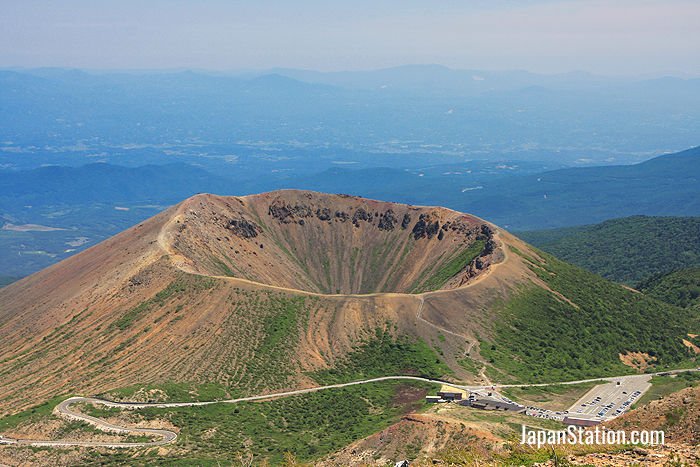
Fukushima Prefecture’s Mt. Azuma-kofuji is an active volcano known for its intact crater and many onsen hot springs nearby
If you love winding mountain roads and stunning panoramic views, this 28-kilometer thoroughfare is the drive for you. It snakes its way through the mountains around Mt. Azuma-kofuji, an active volcano in Fukushima Prefecture that is said to resemble Mt. Fuji. Please note, however, that the road is sometimes closed due to volcanic activity, so be sure to check for the latest updates from Fukushima Prefecture or the Japan Meteorological Agency.
Irohazaka Roads, Tochigi
Rentals available at: Nikko.
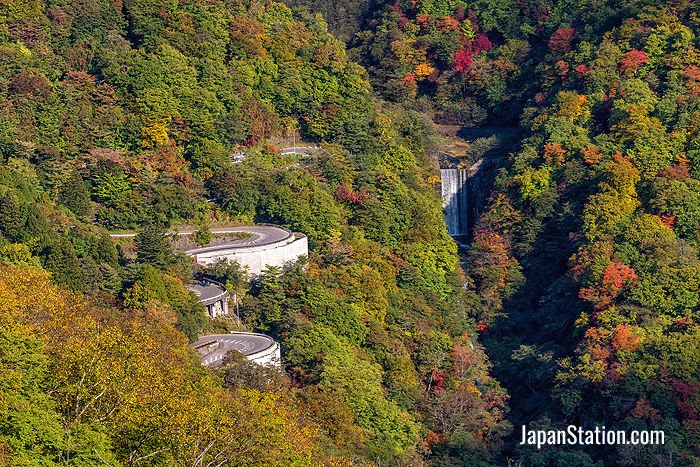
Irohazaka are a pair of roads, one going up a mountainside and the other down, near Nikko
If you love hairpin turns, head to Nikko. The historic town in Tochigi Prefecture north of Tokyo is not only home to the magnificent Toshogu Shrine, a mausoleum for the Tokugawa samurai clan, it’s connected with mountainous Oku-Nikko, home to Mt. Nantai, Lake Chuzenji and Kegon Falls, via a pair of roads that snake up a steep mountainside. They’re named after iroha, the old name for the 48-syllable Japanese alphabet. The Irohazaka roads are especially popular during the fall foliage season, so it’s best to avoid weekends and national holidays.
Tokyo Bay Aqua Line
Rentals available at: Haneda airport, Kawasaki, Tokyo.
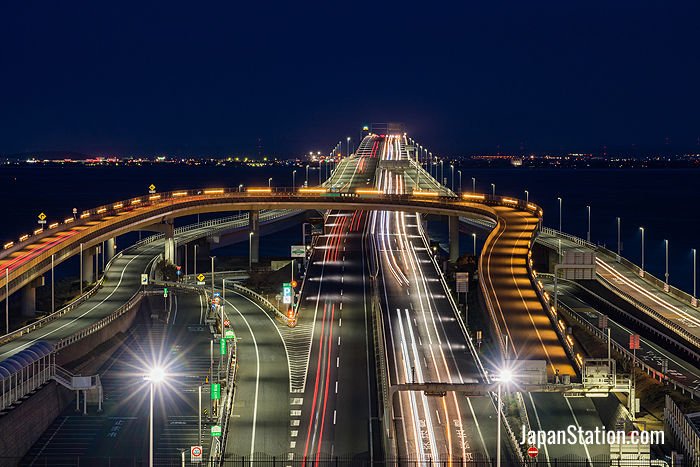
The Tokyo Bay Aqua Line connects Kanagawa and Chiba prefectures via a tunnel and bridge
This 14-km, four-lane thoroughfare connects Kanagawa and Chiba prefectures via a 9.6-km tunnel that goes under Tokyo Bay and an elevated, above-water portion covering about one-third of the distance. The transition from bridge to tunnel is the site of Umihotaru island, home to a rest stop offering eye-popping views of the bay. You can see freighters in the shipping lanes as well as the skyline of Tokyo and Yokohama.
Wangan/Bayshore Route, Tokyo area
Rentals available at: Tokyo.
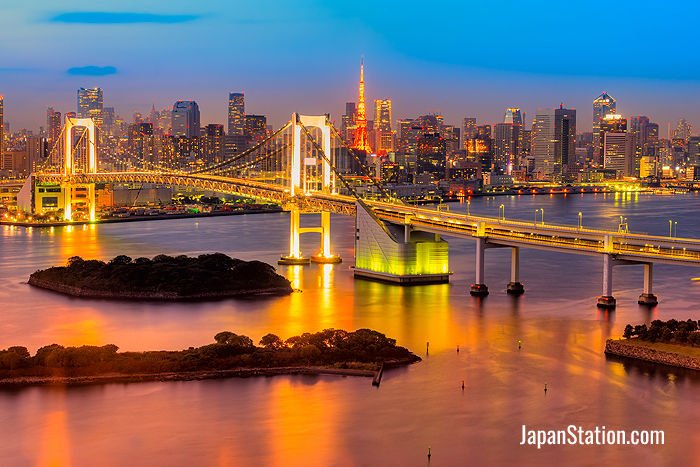
Tokyo’s Rainbow Bridge towers over the Daiba island fortresses constructed in the 19th century
This 70-km stretch of the capital’s Shuto Expressway connects Yokohama, Kanagawa Prefecture with Ichikawa, Chiba Prefecture. A series of bridges and tunnels connecting the artificial islands on Tokyo Bay with the mainland, the Bayshore Route is especially spectacular at night for its city views. Look out for the Rainbow Bridge, Tokyo Tower, Odaiba and Tokyo Skytree.
Hakone Skyline, Shizuoka
Rentals available at: Hakone.
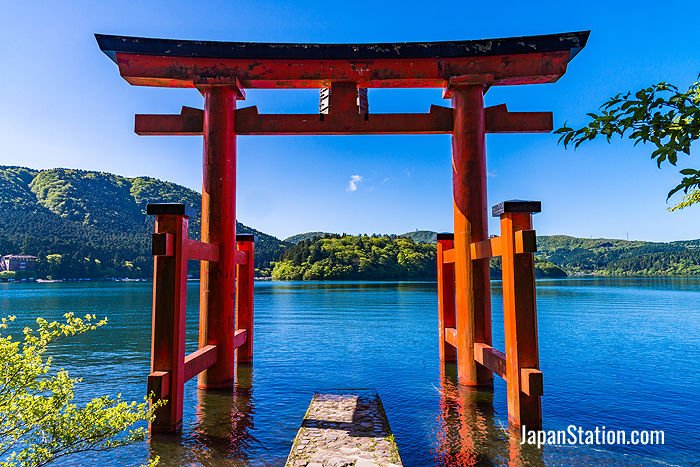
Hakone is known for Hakone-jinja Shrine on Lake Ashi, seen here, and onsen hot springs
Famed as a testing and photography road for new sports cars, the 5-km Hakone Skyline is beloved by motoring enthusiasts for its 58 turns and sweeping views of Mt. Fuji and Lake Ashi. Though the speed limit is 40 kph, be aware that nearly all drivers go much faster here. The entrance toll is 360 yen.
Izu Skyline, Shizuoka
Rentals available at: Atami.
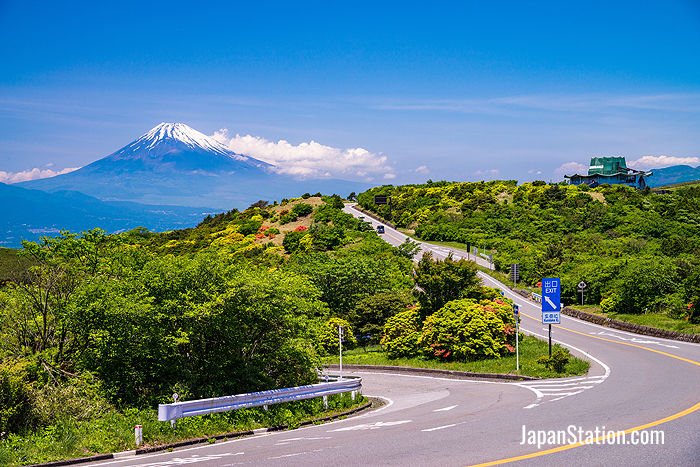
The Izu Skyline road runs at high elevation south of Mt. Fuji
This 40-km toll road rolls through the mountainous eastern half of Shizuoka Prefecture’s Izu Peninsula, linking Atami Pass Interchange in the northern part with Amagi Plateau Interchange in the south. On a clear day, you might get some magnificent views of Mt. Fuji to the north. Takichiyama Observatory, elevation 649 meters, offers a panoramic view of the Pacific Ocean.
Aso Panorama Line, Kumamoto
Rentals available at: Aso Station, Kumamoto Airport, Kumamoto City.
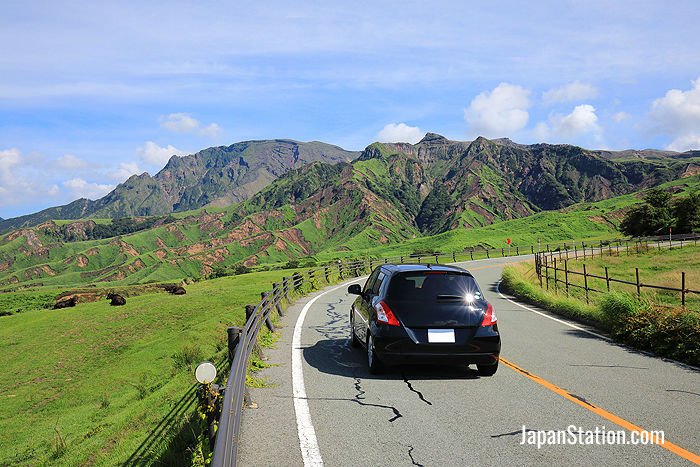
One of the world’s largest volcanoes, Mt. Aso has a giant caldera measuring some 25 kilometers across
Mt. Aso, Japan’s largest active volcano, plays host to this super-scenic drive in Japan’s southernmost main island of Kyushu. Fully restored following damage in the 2016 Kumamoto earthquakes, the Aso Panorama Line is one of several drives in this caldera zone offering stunning volcano views. Because this is an active volcano and earthquake region, however, be sure to check that the roads you want to use are open before you rent a car.
Kaichu Doro (Marine Road), Okinawa
Rentals available at: Naha, Naha Airport.
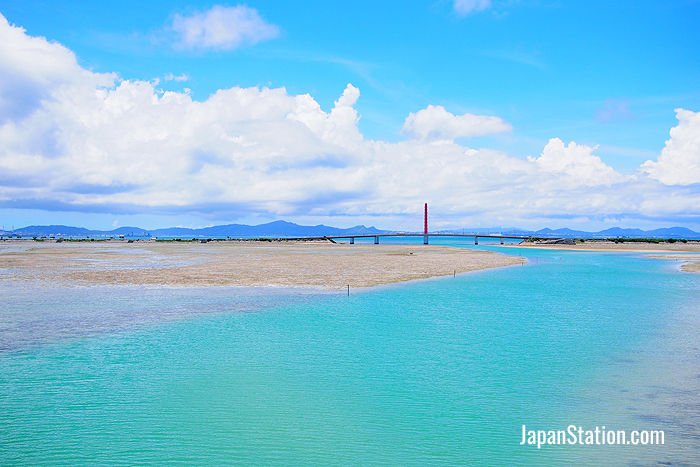
Kaichu-doro Causeway in Okinawa connects Uruma City to several small offshore islands
Japan’s southernmost prefecture dazzles with this 5-km, four-lane road winding along the eastern shores of the main island of Okinawa. It connects the islands of Ikei, Miyagi, Henza, Yabuchi and Hamahiga with Uruma City on the east coast. This is a relatively sleepy, unpopulated part of the main island that’s perfect for a getaway from the bustle of Naha.
Miyakojima bridges, Okinawa
Rentals available at: Miyakojima airport.
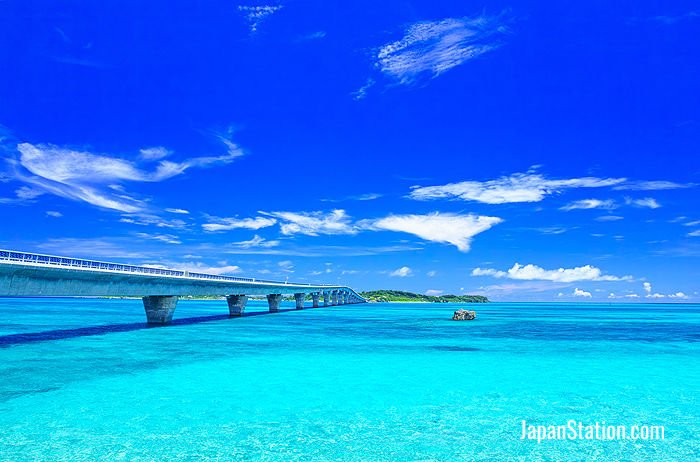
Irabu-Ohashi Bridge in Miyakojima, Okinawa
The Okinawan islands of Miyako, Kurima and Irabu offer beautiful beaches and lush sugarcane fields, but they’re also perfect for seaside drives. You can motor all the way from the small island of Shimoji through Irabu, then over the Irabu-Ohashi Bridge to Miyako, then across Kurima Bridge to tiny Kurima Island. It’s also an easy trip to make on scooter.
Article by Tim Hornyak. All rights reserved.
